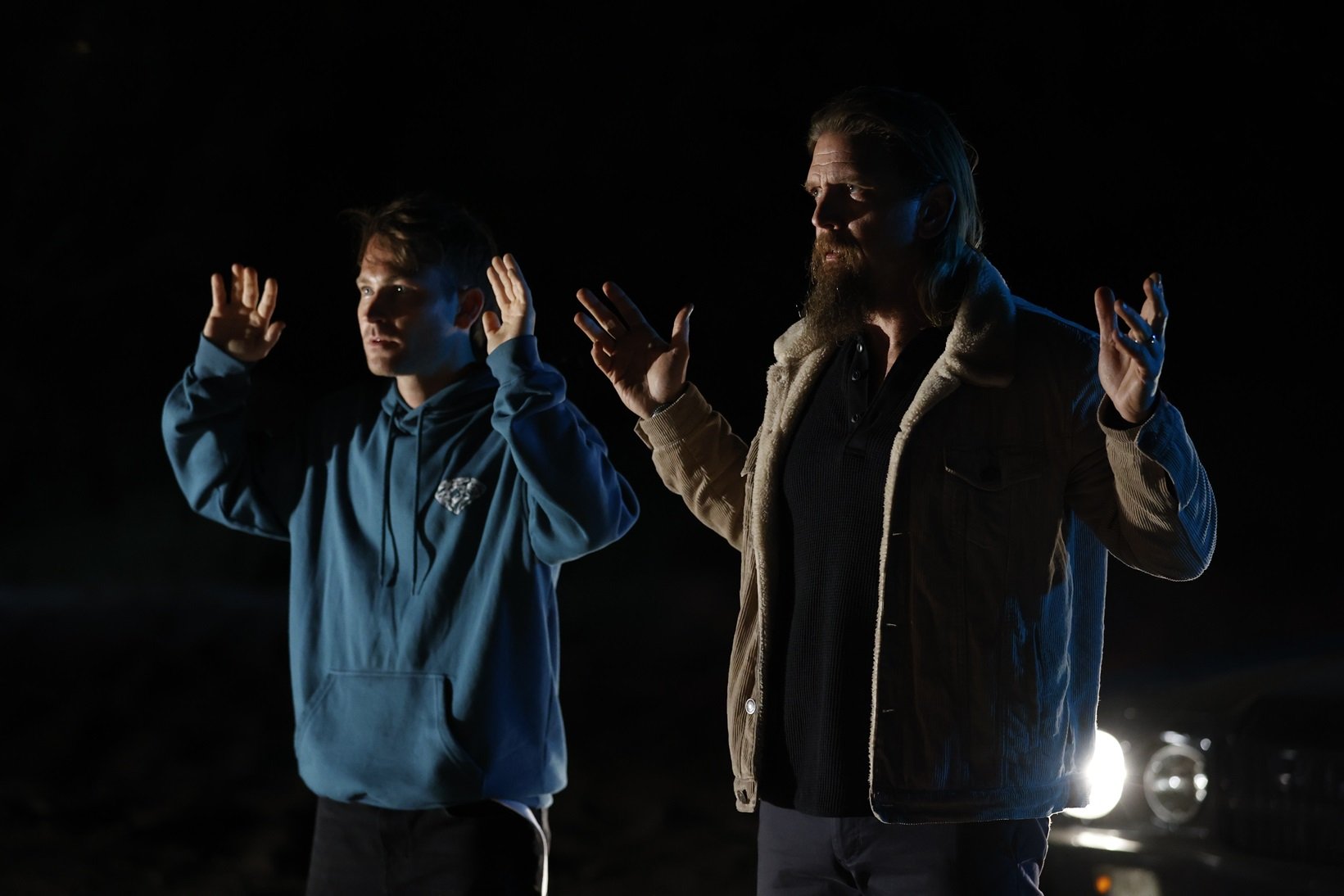This review contains slight spoilers.
There’s a fair bit to admire about Luke Sparke’s work as a director. His debut monster flick Red Billabong (oddly re-released in the US as The Devil Beneath in 2023) took the legend of the yowie away from its modern-chocolate form and into the realm of horror, while the Occupation series was an admirable attempt at a down under Star Wars, replete with a big budget, bombastic special effects, and a global cast as well. I take my hat off to Luke for forging forward with horror and sci-fi films during a time when Australian genre flicks are struggling to gain support from funding bodies and audiences alike.
However, an earnest desire to make genre films doesn’t mean that the results are always great. While I enjoyed the gnarly climax of Red Billabong and the interesting creature design, both exist within a film that is bloated and in need of a script polish or two. Equally so, while I admire the vision of Occupation, it also desperately needed a script edit to whittle down the first-draft level dialogue. Its sequel, Occupation: Rainfall, showed Luke gaining the confidence to navigate a large-scale production on a budget, with the film carrying a breezy, fun vibe that’s elevated by some truly off-the-wall casting decisions that stick the landing – Jason Isaacs voicing an alien named Steve is something I won’t soon forget – albeit, once more, with a script that needed work.
Which brings me to his latest flick, the forgettably titled Bring Him to Me. I had a bit of hope as I sat down for this Aussie-shot, American-set thriller as Luke wasn’t writing this one, with first time feature film writer Tom Evans providing the script. Paired with the impressive cast that includes Barry Pepper, Sam Neill, and Rachel Griffiths, and the moody and suggestive poster, the initial impressions suggested a good time.
Pepper plays a nameless getaway driver ordered to escort Jamie Costa’s thug to a remote location. Costa’s chatty crim comes willingly, eagerly jumping into the driver’s car thinking they’re on the way to ‘get our cut’, unaware what his fate might be. Meanwhile, the driver is assaulted with a barrage of text messages saying, ‘eyes on the road’ and ‘do your job’, with the occasional phone call from Rachel Griffiths demanding he ‘hurry up’. Never since the blackboard badgered Mr Squiggle has there been a more persistent and obnoxious foe present on an Australian screen.
These initial scenes are intercut with two gun-wielding, mask-wearing crims robbing Frank (Sam Neill, clearing doing it for the money) and his son. Paintings adorn the walls and cabinets line the floors of Frank’s shop as he pores over his financial planner; we get the message quick: he’s a wealthy bloke that should not be messed around with. Sure enough, as soon as Frank has a gun in his face, he utters one of the first generic lines of many, ‘No one has ever tried stealing from me and lived long enough to spend a fucking dime.’ After a bit of violence, the money leaves the building and Pepper’s driver escorts the crims to safety. The stakes have been set, and they’re as useless as a two-buck bet on Melbourne Cup day.
Bring Him to Me constantly nods to its genre-brethren in a way that makes you wish you were watching any one of the films it’s referring to. The driver’s vehicle of choice is a black 1970 Ford SS Mustang, a homage to John Wick’s iconic 199 Ford Mustang Mach 1. A character bleeds out in the back seat of a vehicle, immediately reminding us of Reservoir Dogs, and, as if the Tarantino-aspirations aren’t clear enough, there’s even a monologue from Costa’s crim about empathising with superheroes.
With each of these nods to other thrillers adding up, the weight of the crummy dialogue starts to pull the film down even further. ‘Trust is earned.’ ‘If anyone else finds out about this, then you’ll have started a war. A war that you won’t be here to see.’ And my personal favourite, delivered in one of the many static conversations between Pepper and Costa where Costa’s crim feels the need to chatter endlessly like a set of wind-up chattering teeth: ‘You know you don’t have to do this.’ ‘Do what?’ ‘Fill every fucking silence.’ I hear you Barry, I really do.
The crux of the problem with Bring Him to Me is that the basic dialogue creates little intrigue and an infertile foundation for the characters driving this rudimentary plot to become a fleshed-out humans. Attempts to humanise Costa’s crim fall flat; we know he’s got a kid who he wants to take out for ice cream, he stands up for a service station attendant when she’s being harassed, and he clearly wants to be friends with Pepper’s driver. Yet, it quickly becomes clear that these aspects are what he is, not who he is as a person. We get the impression that he has a moral code of sorts, but that doesn’t answer why he became a criminal, nor does it inform what kind of father he is. He talks a lot, but he doesn’t actually say anything.
The character we spend the most time with is Barry Pepper’s driver, and if there’s a saving grace for Bring Him to Me, it’s here. Pepper is a solid actor who understands the depth of the script he’s working with, and as such, does the heavy lifting to imbue his character with some kind of intrigue and mystery and even just a hint of a backstory. The way he talks about being gifted the Mustang when he was younger carries a level of importance, like it means something to him because it meant something to someone he cared about. That level of reverence for the vehicle is swiftly discarded in the closing scenes when the Mustang receives minor damage and Pepper’s driver walks away from it like it’s a Hyundai Getz, suggesting that Barry and Luke were working on completely different levels when it came to constructing his character.
What Barry can do with a look, so can Sam Neill and Rachel Griffiths. Both are fine actors who have delivered some of the most compelling and engaging performances across modern film history, but it doesn’t take much to see that they both took this job because it was an easy role, and it was close to home (the film was shot in Queensland). For the most part, Griffiths quite literally phones her performance in, only appearing in the final act, creating the vibe of ‘you’ve got me one day, and this is all I’m doing’. Neill, ever the consummate professional, endures a walloping, gets to swear a bit, and meets the role on its level it deserves: surface.
Then there’s Jamie Costa. Where Pepper, Griffiths, and Neill each have decades of experience behind them, Costa feels fresh and new, and it shows. It makes complete sense that his career as an actor was boosted by a viral video of him imitating Robin Williams, given his character here feels like a parrot attempting to copy countless actors who work consistently in the stream of 90s Tarantino-imitation thrillers that filled the bottom shelves of video stores.
Costa’s character leans into two of the most prominent of 90s thriller tropes, where he feels like a juvenile being escorted by a crim who ends up creating a parental bond with them, and that he has a life-threatening illness that needs medication on the regular. Early on we see Chekov’s asthma inhaler get pulled out by Costa, creating a level of foreshadowing that becomes expectant rather than anticipatory. Curiously, this is one of the few elements of foreshadowing that actually pays off, with others being presented in inconsequential dialogue that goes nowhere; why mention that the car has a cigarette lighter if you’re not going to use it later on?
It also doesn’t help that for a film that’s shot in Australia and set in America, so many of the actors have shaky American accents. Neill and Griffiths can do solid versions of an American accent, but here they’re barely trying. I’m not usually a stickler for good accents, but what ends up happening is that even though he’s American, Costa’s imitation performance ends up sounding like an Australian trying to do an American accent. Something just doesn’t feel right.
What does feel right is the manner that Luke and cinematographer Ross W. Clarkson shoot the action sequences. They appear like clockwork, and when they do, Bring Him to Me moves with a compelling purpose, creating a level of tension that strips away the artificiality of the performative emotions that the actors do (slamming hands on the driving wheel and yelling loudly is not an emotion). If there’s a reason I continue to watch Luke Sparke’s films, even as they regularly sit on the dull side of mediocrity, it’s because underneath all of the middling dialogue and the stale Jatz cracker characters, the action is both riveting and exciting. I may be overly harsh about everything else with Bring Him to Me, but stage a half-way decent shoot-out (a sequence with blokes on motorbikes is genuinely exciting) and you’ve got me intrigued.
Bring Him to Me wraps up as a pale-imitator of the very best (the action) and the very worst (the script) of 90s thrillers. It’s the kind of film that you’d choose to make up numbers for your weekly video rental bundle and that you’d watch in the early hours of the morning on the day its due back, with the tiredness creating the illusion that it’s a better film than it is. Best viewed half a carton down or as you fight through tiredness.
Director: Luke Sparke
Cast: Barry Pepper, Jamie Costa, Sam Neill
Writer: Tom Evans



